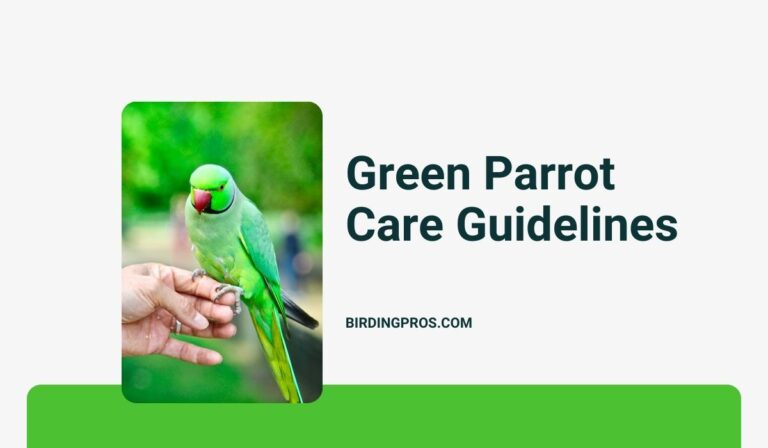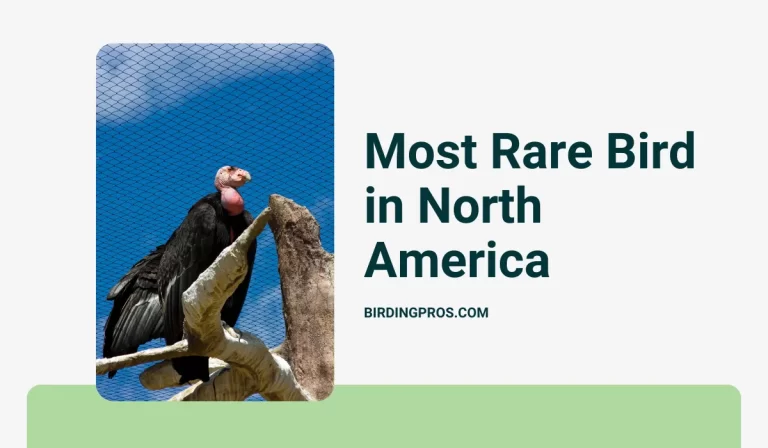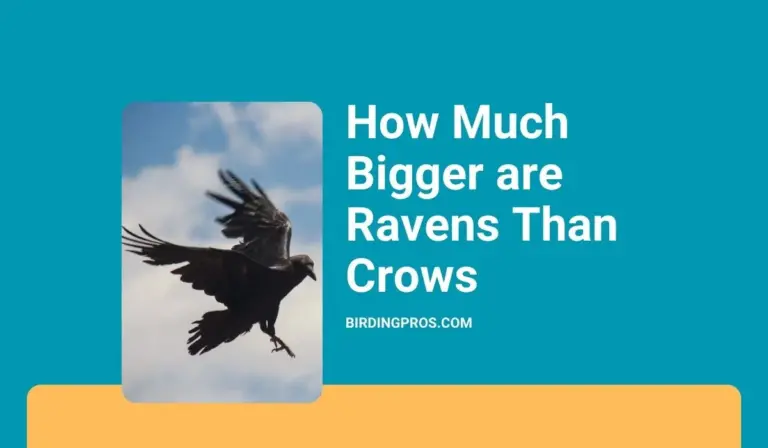10 Birds of Prey in Ontario Canada and Other Notable Birds
Canada is a country of many unique and birds of prey, also known as raptors. These powerful birds are known for their keen eyesight, sharp talons, and hooked beaks, which they use to hunt and consume other animals.
Table of Contents
List of Birds of Prey in Ontario Canada
| Sl | Birds of Prey | Description |
|---|---|---|
| 1 | Bald Eagle (Haliaeetus leucocephalus) | The Bald Eagle is one of the most iconic birds of prey in North America, recognized by its white head and tail feathers contrasting with its dark brown body and wings. |
| 2 | Red-tailed Hawk (Buteo jamaicensis) | A common and widespread hawk in Ontario, the Red-tailed Hawk is recognized by its broad, rounded wings and distinctive red tail. |
| 3 | Peregrine Falcon (Falco peregrinus) | Known as the fastest bird in the world, the Peregrine Falcon can reach speeds of over 320 km/h (200 mph) during its hunting stoop (high-speed dive). |
| 4 | Great Horned Owl (Bubo virginianus) | A large, powerful owl with prominent ear tufts (horns) and a deep hooting call. |
| 5 | Osprey (Pandion haliaetus) | A fish-eating bird of prey with long wings and a distinctive M-shaped flight profile. Often seen hovering over water before diving to catch fish with its sharp talons. |
| 6 | Northern Harrier (Circus hudsonius) | A medium-sized hawk with long wings and a distinctive white rump patch. Known for its low, gliding flight as it hunts for small mammals and birds. |
| 7 | Sharp-shinned Hawk (Accipiter striatus) | The smallest hawk in North America, with short, rounded wings and a long tail. Agile and fast, it primarily preys on small birds. |
| 8 | Cooper’s Hawk (Accipiter cooperii) | Similar to the Sharp-shinned Hawk but larger, with a more rounded tail. Hunts birds and small mammals, often pursuing them through dense foliage. |
| 9 | Rough-legged Hawk (Buteo lagopus) | A large hawk with feathered legs that help protect it from the cold. Typically found in open fields and tundra, often seen in Ontario during the winter. Hunts small mammals by hovering. |
| 10 | Snowy Owl (Bubo scandiacus) | A large, white owl with black markings, the Snowy Owl is a winter visitor to Ontario. Unlike most owls, the Snowy Owl is often active during the day. |
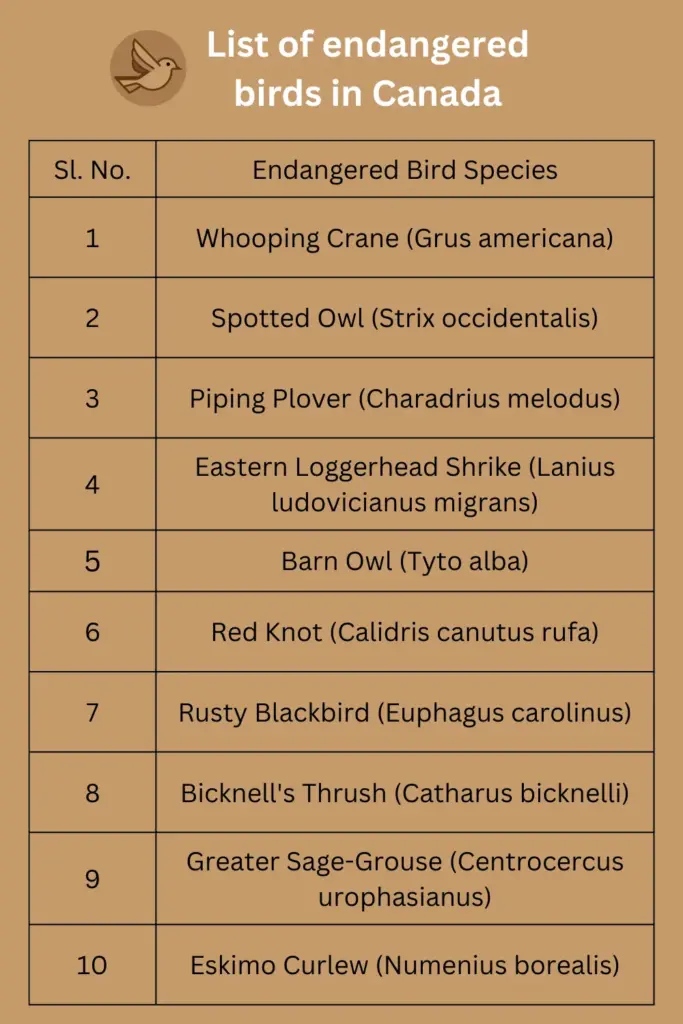
List of endangered birds in Canada
| Sl. No. | Endangered Bird Species |
|---|---|
| 1 | Whooping Crane (Grus americana) |
| 2 | Spotted Owl (Strix occidentalis) |
| 3 | Piping Plover (Charadrius melodus) |
| 4 | Eastern Loggerhead Shrike (Lanius ludovicianus migrans) |
| 5 | Barn Owl (Tyto alba) |
| 6 | Red Knot (Calidris canutus rufa) |
| 7 | Rusty Blackbird (Euphagus carolinus) |
| 8 | Bicknell’s Thrush (Catharus bicknelli) |
| 9 | Greater Sage-Grouse (Centrocercus urophasianus) |
| 10 | Eskimo Curlew (Numenius borealis) |
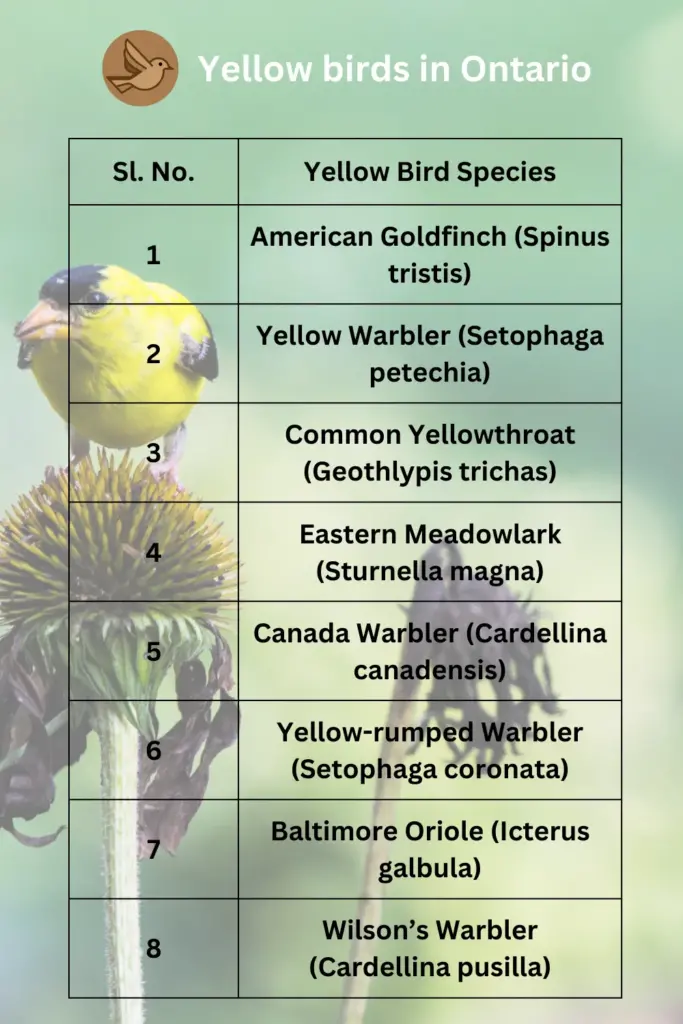
Read More: Birding Hotspots in New Mexico: 10 Best Hotspots
Yellow birds in Ontario Canada
Ontario, Canada, is home to several bird species that feature vibrant yellow plumage. These birds can be spotted in various habitats. Here’s a list of some common yellow birds in Ontario:
| Sl. No. | Yellow Bird Species | Description |
|---|---|---|
| 1 | American Goldfinch (Spinus tristis) | A small, bright yellow bird with black wings and a black cap during the breeding season. The American Goldfinch is commonly found in open fields, meadows, and gardens. |
| 2 | Yellow Warbler (Setophaga petechia) | A small, uniformly yellow warbler with faint reddish streaks on its chest. The Yellow Warbler is often found in wetlands, thickets, and along streams. |
| 3 | Common Yellowthroat (Geothlypis trichas) | This warbler has a bright yellow throat and breast, with males also sporting a distinctive black mask across their face. It is commonly found in marshes, wetlands, and brushy areas. |
| 4 | Eastern Meadowlark (Sturnella magna) | A medium-sized bird with a bright yellow underside and a distinctive black “V” on its chest. The Eastern Meadowlark prefers open fields and grasslands. |
| 5 | Canada Warbler (Cardellina canadensis) | A small warbler with a yellow throat, chest, and belly, and a necklace of black streaks. It is often found in moist, mixed forests. |
| 6 | Yellow-rumped Warbler (Setophaga coronata) | Although not entirely yellow, this warbler has a bright yellow patch on its rump, sides, and crown. It is often seen in a variety of habitats, including forests and shrublands. |
| 7 | Baltimore Oriole (Icterus galbula) | The male Baltimore Oriole has a bright orange-yellow body with black on its head, back, and wings. It is commonly found in deciduous trees, especially near open areas. |
| 8 | Wilson’s Warbler (Cardellina pusilla) | A small warbler with a bright yellow body and a distinctive black cap on its head. Wilson’s Warbler is often found in shrubby, wet areas during migration. |
Birding Tips
Many of these yellow birds can be found in forests, wetlands, and meadows throughout Ontario. Some, like the American Goldfinch and Baltimore Oriole, are also frequent visitors to backyard feeders.
Most of these species are best observed during the spring and summer months when they are breeding and most colorful.
Red birds in Ontario Canada
Here’s a list of some common red birds in Ontario:
| Sl. No. | Red Bird Species | Description |
|---|---|---|
| 1 | Northern Cardinal (Cardinalis cardinalis) | One of the most recognizable birds in North America, the male Northern Cardinal is bright red with a black face mask. It is often found in woodlands, gardens, and suburban areas. |
| 2 | Red-winged Blackbird (Agelaius phoeniceus) | The male Red-winged Blackbird is black with distinctive red and yellow shoulder patches. It is commonly found in wetlands, marshes, and along roadside ditches. |
| 3 | Scarlet Tanager (Piranga olivacea) | The male Scarlet Tanager is brilliant red with black wings and tail. It is usually found in deciduous forests during the breeding season. |
| 4 | House Finch (Haemorhous mexicanus) | The male House Finch has a rosy red face, chest, and rump. It is often found in urban areas, parks, and gardens, where it frequents feeders. |
| 5 | Purple Finch (Haemorhous purpureus) | Despite its name, the male Purple Finch is more of a raspberry red all over. It is commonly found in coniferous and mixed forests, as well as at bird feeders. |
| 6 | Common Redpoll (Acanthis flammea) | A small finch with a red forehead and black chin. It is often found in flocks during the winter months, particularly in open woodlands and at feeders. |
| 7 | Red-breasted Nuthatch (Sitta canadensis) | A small bird with a rusty-red breast and a distinctive black-and-white striped face. It is commonly found in coniferous forests and at feeders, often climbing down tree trunks. |
| 8 | Pine Grosbeak (Pinicola enucleator) | The male Pine Grosbeak is a large, chunky finch with rosy-red plumage. It is typically found in boreal forests, often seen in flocks during the winter months. |
| 9 | Red Crossbill (Loxia curvirostra) | The Red Crossbill has brick-red plumage with crossed bill tips adapted for extracting seeds from conifer cones. It is commonly found in coniferous forests. |
| 10 | Summer Tanager (Piranga rubra) | The male Summer Tanager is entirely red and is occasionally spotted in Ontario during migration. It is more commonly found in the southern United States. |
Read More: Birding Hotspots in Idaho: Discover the Best Sites for Birdwatching
How do birds survive winter in Canada?
Birds in Canada employ various strategies to survive the harsh winter months. These strategies vary depending on the species, their habitat, and their specific adaptations. Here are some of the key ways.
1. Migration
Description: Many bird species, particularly those that rely on insects or other food sources that become scarce in winter, migrate to warmer regions.
For example, most warblers, swallows, and hummingbirds leave Canada in the fall and head to the southern United States, Central America, or even South America.
Examples: Birds like the Ruby-throated Hummingbird and the Baltimore Oriole migrate south to avoid the winter cold.
2. Physical Adaptations
Fluffing Feathers: Birds fluff up their feathers to trap air, which acts as insulation against the cold. The more air they trap, the better they can retain body heat.
Fat Reserves: In preparation for winter, many birds build up fat reserves by eating more in the fall. This fat serves as an energy source during the colder months when food is less abundant.
Down Feathers: Some birds grow extra down feathers in the fall. Down feathers are incredibly effective at trapping heat and providing insulation.
3. Behavioral Adaptations
Huddling: Some birds, like chickadees, will huddle together in cavities or dense foliage to share body heat and reduce exposure to the cold.
Shivering: Birds can shiver to generate heat through muscle activity, similar to how mammals warm up. This is a last resort to maintain body temperature.
Reducing Activity: To conserve energy, birds may reduce their activity levels, spending more time resting and less time flying.
4. Finding Shelter
- Roosting in Protected Areas: Birds seek out sheltered spots to roost during the night or in severe weather. This could include tree cavities, dense evergreen trees, birdhouses, or even tucked-away spots on buildings.
- Use of Human Structures: Some birds, like pigeons and sparrows, take advantage of urban environments, finding warmth and shelter in man-made structures such as barns, attics, and even under bridges.
5. Foraging and Food Storage
Caching Food: Birds like chickadees and jays store food in various hidden locations (caching) during the fall. They return to these caches throughout the winter to feed.
Foraging in Groups: Birds such as finches and sparrows often forage in flocks during winter. This not only increases the chance of finding food but also provides safety in numbers.
6. Adapted Diets
Switching Diets: Some birds change their diets in winter. For instance, woodpeckers and nuthatches rely more on seeds, nuts, and berries, which are more readily available than insects in the winter.
Utilizing Bird Feeders: Many birds take advantage of backyard bird feeders stocked with seeds, suet, and other high-energy foods that help them survive the winter.
7. Torpor
Entering Torpor: Some small birds, such as chickadees, can enter a state of torpor, where they lower their body temperature and metabolic rate to conserve energy. This is a short-term solution to survive particularly cold nights.
8. Specialized Feet
Countercurrent Heat Exchange: Birds have a specialized circulatory system in their legs and feet that helps minimize heat loss. Warm arterial blood warms the cooler venous blood returning from the extremities, reducing overall heat loss.
Conclusion
Canada’s bird life offers a unique opportunity to connect with nature and observe some of the world’s most beautiful and intriguing avian species.
From majestic bald eagles to colorful warblers and rare migratory visitors, Canada’s birds are a vital part of its natural heritage.


